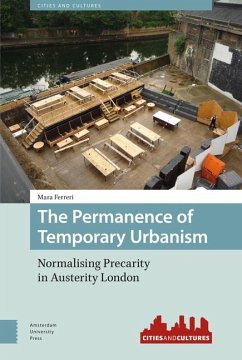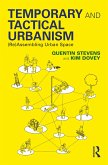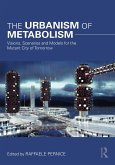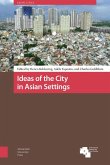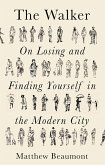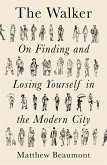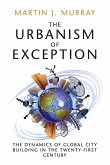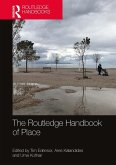- Gebundenes Buch
- Merkliste
- Auf die Merkliste
- Bewerten Bewerten
- Teilen
- Produkt teilen
- Produkterinnerung
- Produkterinnerung
This book offers a critical exploration of the emergence and establishment of temporary urbanism, as a seductive discourse and as an entangled field of practice encompassing architecture, visual and performative arts, urban regeneration policies and planning.
Andere Kunden interessierten sich auch für
![Temporary and Tactical Urbanism Temporary and Tactical Urbanism]() Quentin StevensTemporary and Tactical Urbanism36,99 €
Quentin StevensTemporary and Tactical Urbanism36,99 €![The Urbanism of Metabolism The Urbanism of Metabolism]() The Urbanism of Metabolism56,99 €
The Urbanism of Metabolism56,99 €![Ideas of the City in Asian Settings. Ideas of the City in Asian Settings.]() Henco BekkeringIdeas of the City in Asian Settings.214,99 €
Henco BekkeringIdeas of the City in Asian Settings.214,99 €![The Walker The Walker]() Matthew BeaumontThe Walker24,99 €
Matthew BeaumontThe Walker24,99 €![The Walker The Walker]() Matthew BeaumontThe Walker15,99 €
Matthew BeaumontThe Walker15,99 €![The Urbanism of Exception The Urbanism of Exception]() Martin J. Murray (Ann Arbor University of Michigan)The Urbanism of Exception37,99 €
Martin J. Murray (Ann Arbor University of Michigan)The Urbanism of Exception37,99 €![The Routledge Handbook of Place The Routledge Handbook of Place]() The Routledge Handbook of Place53,99 €
The Routledge Handbook of Place53,99 €-
-
-
This book offers a critical exploration of the emergence and establishment of temporary urbanism, as a seductive discourse and as an entangled field of practice encompassing architecture, visual and performative arts, urban regeneration policies and planning.
Produktdetails
- Produktdetails
- Cities and Cultures
- Verlag: Amsterdam University Press
- Seitenzahl: 196
- Erscheinungstermin: 11. März 2021
- Englisch
- Abmessung: 240mm x 161mm x 15mm
- Gewicht: 458g
- ISBN-13: 9789462984912
- ISBN-10: 9462984913
- Artikelnr.: 69032118
- Herstellerkennzeichnung
- Libri GmbH
- Europaallee 1
- 36244 Bad Hersfeld
- gpsr@libri.de
- Cities and Cultures
- Verlag: Amsterdam University Press
- Seitenzahl: 196
- Erscheinungstermin: 11. März 2021
- Englisch
- Abmessung: 240mm x 161mm x 15mm
- Gewicht: 458g
- ISBN-13: 9789462984912
- ISBN-10: 9462984913
- Artikelnr.: 69032118
- Herstellerkennzeichnung
- Libri GmbH
- Europaallee 1
- 36244 Bad Hersfeld
- gpsr@libri.de
Mara Ferreri is an urban and cultural geographer. She is VC Research Fellow in the Department of Geography and Environmental Sciences at Northumbria University, UK, and is the co-author of Notes from the Temporary City (Public Works, 2016).
Chapter 1. Temporary urbanism: a situated approach
Reclaiming spaces and the role of temporariness
The trope of temporariness as 'alterity'
For a situated approach to temporary urbanism
'Post-crisis' London
The book's questions
Chapter 2. The entangled field of temporary urbanism
The emergence of a discourse
Countering recessional perceptions
'Creative' fillers
Art showcasing to the world: pop-up in the shadow of the 2012 Games
The rise of the pop-up intermediary
Meanwhilers: a clever rebranding
The Meanwhile London Competition
Enrolling urban professionals in the shift to austerity
The unresolved question of unlawful occupations
Conclusion: the primacy of property
Chapter 3. 'Not a pop-up!'
The experience of performers and visual artists
A well-established history
'Provided you can beg
steal or borrow a space'
Group+Work and 1990s myths in public commissioning
Pop-ups in Westminster
ArtEvict in 'forgotten spaces'
Settling down in Hackney Wick Fish Island? Pop-up spaces as festivals and digital arts incubators
Conclusions: in the cracks of the creative city promise
Chapter 4. Staging temporary spaces
Experiential economies and the performativity of urban activation
The Elephant as a site for 'community engagement'
Studio at the Elephant
A strategy of open programming
Visibility for recognition
Mediating face-to-face interactions
Empowerment for surrender? Conclusions: the openness of agonistic encounters
Chapter 5. Planning a temporary city of on-demand communities
Temporariness in planning at times of austerity
'Stitching the fringes' before and after the Olympics
Learning from Others: interim uses as urban 'testing sites'
Vacant land and setting up a temporary community hub
Young people and the 'two communities'
Risky grassroots
Temporary 'urban vitality' in the LLDC Local Plan (2015-2031)
'Seeding' long-term uses
Learning to become 'on-demand communities'
Conclusions: the risk of planned precarization
Chapter 6. The normalisation of temporariness
Underused spaces as a 'problem'
The projective logic
Ephemeral architectures
Permanent 'times of uncertainty'
Tactical or precarious acting? Precarity as temporal foreclosure
Conclusion: reclaiming urban space-time after the pop up
Index
Bibliography.
Reclaiming spaces and the role of temporariness
The trope of temporariness as 'alterity'
For a situated approach to temporary urbanism
'Post-crisis' London
The book's questions
Chapter 2. The entangled field of temporary urbanism
The emergence of a discourse
Countering recessional perceptions
'Creative' fillers
Art showcasing to the world: pop-up in the shadow of the 2012 Games
The rise of the pop-up intermediary
Meanwhilers: a clever rebranding
The Meanwhile London Competition
Enrolling urban professionals in the shift to austerity
The unresolved question of unlawful occupations
Conclusion: the primacy of property
Chapter 3. 'Not a pop-up!'
The experience of performers and visual artists
A well-established history
'Provided you can beg
steal or borrow a space'
Group+Work and 1990s myths in public commissioning
Pop-ups in Westminster
ArtEvict in 'forgotten spaces'
Settling down in Hackney Wick Fish Island? Pop-up spaces as festivals and digital arts incubators
Conclusions: in the cracks of the creative city promise
Chapter 4. Staging temporary spaces
Experiential economies and the performativity of urban activation
The Elephant as a site for 'community engagement'
Studio at the Elephant
A strategy of open programming
Visibility for recognition
Mediating face-to-face interactions
Empowerment for surrender? Conclusions: the openness of agonistic encounters
Chapter 5. Planning a temporary city of on-demand communities
Temporariness in planning at times of austerity
'Stitching the fringes' before and after the Olympics
Learning from Others: interim uses as urban 'testing sites'
Vacant land and setting up a temporary community hub
Young people and the 'two communities'
Risky grassroots
Temporary 'urban vitality' in the LLDC Local Plan (2015-2031)
'Seeding' long-term uses
Learning to become 'on-demand communities'
Conclusions: the risk of planned precarization
Chapter 6. The normalisation of temporariness
Underused spaces as a 'problem'
The projective logic
Ephemeral architectures
Permanent 'times of uncertainty'
Tactical or precarious acting? Precarity as temporal foreclosure
Conclusion: reclaiming urban space-time after the pop up
Index
Bibliography.
Chapter 1. Temporary urbanism: a situated approach
Reclaiming spaces and the role of temporariness
The trope of temporariness as 'alterity'
For a situated approach to temporary urbanism
'Post-crisis' London
The book's questions
Chapter 2. The entangled field of temporary urbanism
The emergence of a discourse
Countering recessional perceptions
'Creative' fillers
Art showcasing to the world: pop-up in the shadow of the 2012 Games
The rise of the pop-up intermediary
Meanwhilers: a clever rebranding
The Meanwhile London Competition
Enrolling urban professionals in the shift to austerity
The unresolved question of unlawful occupations
Conclusion: the primacy of property
Chapter 3. 'Not a pop-up!'
The experience of performers and visual artists
A well-established history
'Provided you can beg
steal or borrow a space'
Group+Work and 1990s myths in public commissioning
Pop-ups in Westminster
ArtEvict in 'forgotten spaces'
Settling down in Hackney Wick Fish Island? Pop-up spaces as festivals and digital arts incubators
Conclusions: in the cracks of the creative city promise
Chapter 4. Staging temporary spaces
Experiential economies and the performativity of urban activation
The Elephant as a site for 'community engagement'
Studio at the Elephant
A strategy of open programming
Visibility for recognition
Mediating face-to-face interactions
Empowerment for surrender? Conclusions: the openness of agonistic encounters
Chapter 5. Planning a temporary city of on-demand communities
Temporariness in planning at times of austerity
'Stitching the fringes' before and after the Olympics
Learning from Others: interim uses as urban 'testing sites'
Vacant land and setting up a temporary community hub
Young people and the 'two communities'
Risky grassroots
Temporary 'urban vitality' in the LLDC Local Plan (2015-2031)
'Seeding' long-term uses
Learning to become 'on-demand communities'
Conclusions: the risk of planned precarization
Chapter 6. The normalisation of temporariness
Underused spaces as a 'problem'
The projective logic
Ephemeral architectures
Permanent 'times of uncertainty'
Tactical or precarious acting? Precarity as temporal foreclosure
Conclusion: reclaiming urban space-time after the pop up
Index
Bibliography.
Reclaiming spaces and the role of temporariness
The trope of temporariness as 'alterity'
For a situated approach to temporary urbanism
'Post-crisis' London
The book's questions
Chapter 2. The entangled field of temporary urbanism
The emergence of a discourse
Countering recessional perceptions
'Creative' fillers
Art showcasing to the world: pop-up in the shadow of the 2012 Games
The rise of the pop-up intermediary
Meanwhilers: a clever rebranding
The Meanwhile London Competition
Enrolling urban professionals in the shift to austerity
The unresolved question of unlawful occupations
Conclusion: the primacy of property
Chapter 3. 'Not a pop-up!'
The experience of performers and visual artists
A well-established history
'Provided you can beg
steal or borrow a space'
Group+Work and 1990s myths in public commissioning
Pop-ups in Westminster
ArtEvict in 'forgotten spaces'
Settling down in Hackney Wick Fish Island? Pop-up spaces as festivals and digital arts incubators
Conclusions: in the cracks of the creative city promise
Chapter 4. Staging temporary spaces
Experiential economies and the performativity of urban activation
The Elephant as a site for 'community engagement'
Studio at the Elephant
A strategy of open programming
Visibility for recognition
Mediating face-to-face interactions
Empowerment for surrender? Conclusions: the openness of agonistic encounters
Chapter 5. Planning a temporary city of on-demand communities
Temporariness in planning at times of austerity
'Stitching the fringes' before and after the Olympics
Learning from Others: interim uses as urban 'testing sites'
Vacant land and setting up a temporary community hub
Young people and the 'two communities'
Risky grassroots
Temporary 'urban vitality' in the LLDC Local Plan (2015-2031)
'Seeding' long-term uses
Learning to become 'on-demand communities'
Conclusions: the risk of planned precarization
Chapter 6. The normalisation of temporariness
Underused spaces as a 'problem'
The projective logic
Ephemeral architectures
Permanent 'times of uncertainty'
Tactical or precarious acting? Precarity as temporal foreclosure
Conclusion: reclaiming urban space-time after the pop up
Index
Bibliography.

